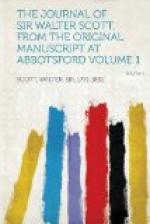Falkland has most interesting remains. A double entrance-tower, and a side building running east from it, is roofed, and in some degree habitable; a corresponding building running northward from the eastern corner is totally ruinous, having been destroyed by fire. The architecture is highly ornamented, in the style of the Palace at Stirling. Niches with statues, with projections, cornices, etc, are lavished throughout. Many cornice medallions exhibited such heads as those procured from the King’s room at Stirling, the originals, perhaps, being the same. The repeated cypher of James V. and Mary of Guise attest the builder of this part of the palace. When complete it had been a quadrangle. There is as much of it as remained when Slezer published his drawings. Some part of the interior has been made what is called habitable, that is, a half-dozen of bad rooms have been gotten out of it. Am clear in my own mind a ruin should be protected, but never repaired. The proprietor has a beautiful place called Nut-hill, within ten minutes’ walk of Falkland, and commanding some fine views of it and of the Lomond Hill. This should be the residence. But Mr. Bruce and his predecessor, my old professor, John Bruce,[349] deserve great credit for their attention to prevent dilapidation, which was doing its work fast upon the ancient palace. The only remarkable apartment was a large and well-proportioned gallery with a painted roof—tempore Jacobi Sexti—and built after his succession to the throne of England. I noticed a curious thing,—a hollow column concealed the rope which rung the Castle bell, keeping it safe from injury and interruption.
The town of Falkland is old, with very narrow streets. The arrival of two carriages and a gig was an event important enough to turn out the whole population. They are said to be less industrious, more dissipated, and readier to become soldiers than their neighbours. So long a court retains its influence!
We dined at Wellfield with my Mend George Cheape, with whom I rode in the cavalry some thirty years ago. Much mirth and good wine made us return in capital tune. The Chief Baron and Admiral Adam did not go on this trip. When we returned it was time to go to bed by a candle.
June 28.—Being Sunday, we lounged about in the neighbourhood of the crags called Kiery Craigs, etc. The Sheriff-substitute of Kinross came to dinner, and brought a gold signet[350] which had been found in that town. It was very neat work, about the size of a shilling. It bore in a shield the arms of Scotland and England, parti per pale, those of Scotland occupying the dexter side. The shield is of the heater or triangular shape. There is no crown nor legend of any kind; a slip of gold folds upwards on the back of the hinge, and makes the handle neatly enough. It is too well wrought for David II.’s time, and James IV. is the only monarch of the Scottish line who, marrying a daughter of England, may carry the arms of both countries parti per pale. Mr. Skelton is the name of the present possessor.




